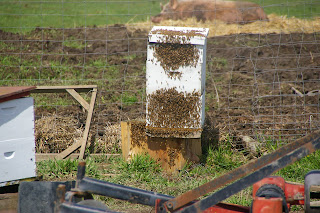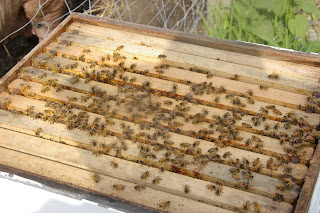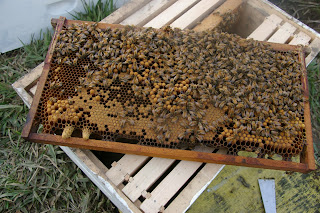The bees basic agenda is different than our human agenda. We want honey, and maybe more bees. The bees want more bees, and use honey towards that end. So my job in managing my hives is to give the bees what they need, and direct their industry towards my goal -- honey.
After the bees returned to their hive I let them settle down for an hour or so, and then got dressed up in my beekeeping gear and popped the top on the hive. This is with the lid off, and having this many bees on top of the hive means that they're feeling pretty crowded. Pretty consistent with a swarm.
In Western Washington, the bottom two boxes of a beehive are for the bees. Take a look at the first picture. You'll notice that the lower two parts are bigger than the top box. A full "super" -- which is what the first two boxes are called -- weighs around 110lbs. The smaller box, full of honey, weighs about 60lbs. I use the smaller boxes to collect my honey so that I can lift them off the hive when I'm collecting it. The bees use the larger box to raise their young and use the other box to store enough honey to last through the winter. Bees don't hibernate; they just cluster in the hive and eat the stored honey.
The honey comb in the picture above has new honey in it. That means the bees are finding something that has nector, and they're busily storing it away. Good healthy colony. The uncapped honeycomb is honey that the bees haven't dehydrated enough. When it gets to the right moisture level, they'll cap it, too. The center area, that shows as light yellow, is capped new honey. Yummy!
I pull the top box off (it's about 40lbs right now, about 2/3rds full) and take a look at the next box down. Lots of bees here. healthy hive, and the bees are feeling crowded. I'm going to pull some of the frames and see if there are swarm cells. Swarm cells are new queen bees that haven't hatched yet.
Yep, swarm cells. Queen bees are bigger than regular bees or drones, and when the bees make a new queen they'll build cells like this. neither of these cells have hatched, but they are close to hatching. The first new queen that hatches will go through the hive and sting to death any other queens that haven't hatched yet. In a typical hive that is about to swarm there will be between 5 and 15 queen cells scattered throughout the hive. Bees believe in backups.
Here you can see the entire frame. The swarm cells are on the lower left. Immediately above them are drone cells; these are the only male bees in the hive, and this hive has decided to raise a good crop of them. You'll see drone cells on the lower right as well; a double row of them. The relatively flat larvae in the center are regular worker bees. The queen lays eggs, the workers feed the larvae until they're old enough to cap, and then cap them. The new bees chew their way out of their cells. So a capped cell is a developing bee that hasn't hatched.
Now we get to the nitty gritty. Working my way through the frames I find 7 swarm cells, and I'd like to split this hive. So what I do is take a frame of capped brood, a frame of honey, and some brand-new frames, and put them into a hive body, a super. Into each of these I cut out two swarm cells and carefully place them. The two queens will hatch, fight it out, and figure that they've emerged into a hive that has just swarmed.
In a swarm, it's the older queen that leaves with about half the bees, so the newly-hatched queens find themselves in a queenless colony iwth some brood and some workers - I'm just splitting the hive more than a swarm would.
The new frames on either side are flat sheets of beeswax that are stamped with the honeycomb pattern. The bees will draw this comb out, consuming honey as they do so, and building new comb.
A natural swarm takes about 1/2 of the bees in the hive with it. I'm being more aggressive in my split, splitting this single hive into 3 new hives and the old hive, for a total of 4. Because there will be fewer worker bees than usual, I'll feed them a bit of sugar over the next couple of weeks to give them a good start.









Fascinating. Thanks for these two posts on the bees Bruce!
ReplyDelete